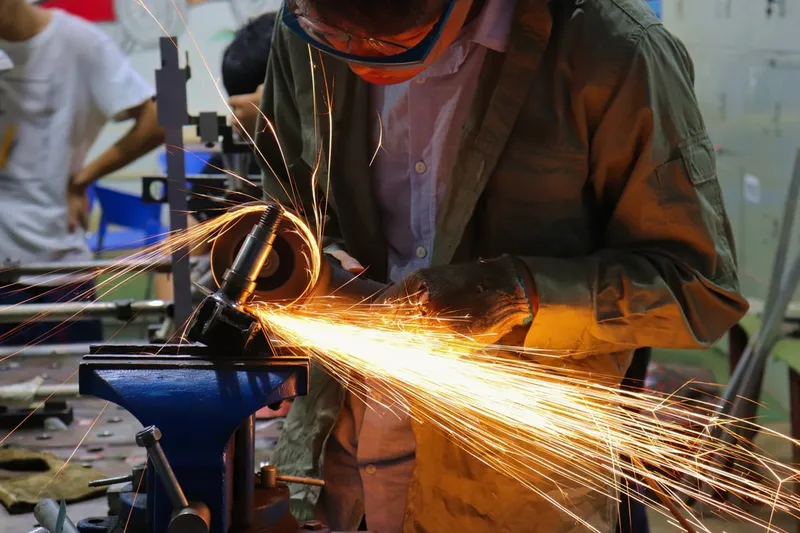

Digital Transformation Trends in The Automotive Industry For 2019
Car manufacturing has moved beyond automation, to a whole new kind of digitized factory, which produces more than 100 million lines of code per each connected vehicle. This changes the way the industry operates, by demanding a different kind of workers and new business models in general.

Photo by Marc Kleen
Today we couldn’t imagine our lives without network connectivity. All of our daily activities are slowly getting digitized. Digital Transformation has taken over the business as well. In fact, research shows that 76% of companies are investing in emerging technology. Furthermore, according to Gartner, 15% of all customer service interactions will be handled solely by AI in 2021, which is a 400% increase from 2017.
The process of global digital transformation and technological advancements of our age put the automotive industry in a state of disruptive transition. Modern customers want full connectivity. Their fast-changing needs and expectations are challenging for manufacturers. The constant demand for more digitized experience forces them to incorporate technological offerings.
The automotive industry is not an exception. Seamless connectivity and the most convenient driving experience possible is what today’s customer wants. That’s why innovations like IoT and Artificial Intelligence make an impact on the automotive industry in 2019, meaning that the focus will be mostly on connected vehicles.
Car manufacturing has moved beyond automation, to a whole new kind of digitized factory, which produces more than 100 million lines of code per each connected vehicle. This changes the way the industry operates, by demanding a different kind of workers and new business models in general.
All this leads to new transformation trends coming to the automotive industry each year. So, without further due, let’s have a look at some of them that would have the biggest impact in 2019.
Connectivity
That’s the word that perfectly matches the vibe of 2019. It has been buzzing around for quite some time now, but this year connectivity is no longer just a nice addition, but rather a necessity demanded by users.

Photo by Marc Kleen
Today’s drivers want their access to social media, music, and apps while driving, to not be restricted. They want to use these features, just like they would while sitting on the couch. This means that vehicles are no longer limited productivity space.
To fulfill these needs and wishes, manufacturers now produce cars that give us the ability to continue with our social or business life, or whatever we want while driving. You’ve probably dreamed about WiFi connection in your vehicle. Guess what, that’s finally available. The WiFi-equipped cars are also a creation driven by the constant need for connectivity.
Car manufacturers are realizing they can’t sell their products without these connectivity features anymore, so that makes them invest more. Every aspect on the factory floor is now digitized to match consumer environments, which leads us to the next transformation trend.
Connected Supply Chain And Improved Manufacturing

Photo by Xi Wang
As we already mentioned and we see in other industries, digital transformation trends are being used to personalize a consumer’s experience and customized to his needs. With the automotive industry, it’s just the same.
Digitizing the connected supply chain drives costs down, engages the consumers more effectively, and collects and uses data for their better service. We see that the industry is moving away from regional production and towards a more decentralized approach.
In fact, 74% of executives believe that production in Western Europe will be less than 5% by 2030 (2017: 65% ). This allows not only for lower costs but more transparency in the supply chain as well. It also accelerates the processes of manufacturing, design and delivery.
The possibilities of communication that the Internet of Things provides, allows instant feedback to a smart factory. On the other hand, this type of factory uses advanced algorithms and Artificial Intelligence to perform tasks like creating schedules and managing workflow. Furthermore, it has robots working alongside humans on assembly lines. These transformative technologies increase productivity and decrease defect rates significantly.
The giant improvements to production, flexibility, and performance are set to overcome the obvious financial barriers in constructing smart factories.
Predictive Maintenance
Predictive maintenance technology is based on the use of IoT connectivity tools that collect data on the performance, transfer it to the cloud and evaluate any risks of potential malfunctions of a vehicle’s hardware or software. After processing the information, the driver is notified and advised of any necessary service to avoid incidents.
This means no more guesswork and emergency stops for car maintenance since today’s vehicles let us know when they need maintenance or replacement. You'll know if there’s a problem even before it occurs.
Service of vehicles has also become digitized. Now it requires not only mechanical attention but also a tech-savvy technician to maintain and update software. This means optimized vehicular performance for longer periods of time.
Another thing that is becoming a possibility is remote service. A digital interface allows over-the-air updates. Imagine going to an Apple store every time you need to update your iPhone. Frustrating, isn’t it? Now it’s like that with your car’s software, but remote service will allow this over-the-air, so you can update it whenever and wherever you like.
This predictive capability is extremely beneficial to the trucking industry as well. Sensor technologies and IoT allow companies to monitor data, ensure truck safety, fuel optimization and even monitoring of cargo. Statistics show that this solution has strong results, which include improvements of over 30% in truck up-time and the prediction of failure’s 30 days in advance at an accuracy rate of 90%.
Protection and Data Security
The automotive industry is the second most data-driven industry in the world. The new smart vehicles collect data about drivers, their destinations, routes, traffic patterns and so on. Automotive manufacturing and software developing companies continue their work on establishing levels of customer loyalty, so users are at the center of all efforts.
Data is used to communicate with and engage drivers. However, the connected software systems must be secure in order to protect consumer data. Manufacturers understand the importance of security and protection and they’re always in search of new advancements. It’s also the reason digital transformation has been a key talking point of many established industry specialists and experts.
Such kinds of widespread changes pose challenges, especially security ones to any industry. However, the digital revolution of the automotive one is able to outweigh any challenge.
Mobility-As-a-Service (MaaS)
With a dominating private and public ride-sharing, vehicles have become another element of connected living. Uber, for example, has gained massive success in its sphere. It started the shift from privately owned cars to service-oriented forms of transport. Such startups present consumers with financial relief. They’ve eliminated big expenses like the cost of purchasing a vehicle, maintenance and licensing.
MaaS provides some great advantages and big saving to consumers. This has made the automotive industry opt-in. Volkswagen, for instance, is forging the way with its own ride-sharing app. For sure Uber and Lyft were just the beginning of Mobility-as-a-service and there’re will be new existing platforms in the very near future.
A Digitized Automotive Industry
Technological advancements being used in the automotive industry will be something very common sooner than you think. Digital transformation impacts it in a beneficial way for users and the environment as well.
The automotive industry in 2019 is changed for good. There are still many challenges manufacturers will have to overcome in order to keep up with the process of digital transformation.
However, the trends we discussed above are still a work in progress but are set to change the way the industry operates, as well as how we use vehicles. 2019 is another exciting year of changes and challenges, that takes us a step closer to a digital future.






